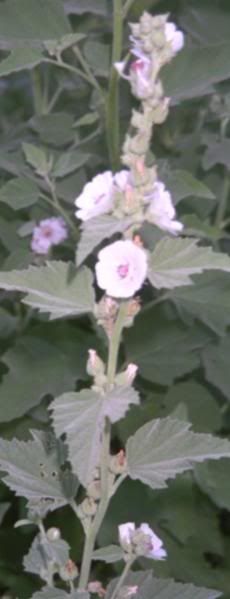

Althea (Althaea officinalis)
Folk Names: Althaea, Cheeses, Guimauve (French), Hocys Bendigaid (Welsh), Mallards, Marshmallow, Mauls, Mortification Root, Schloss Tea, Sweet Weed, Wymote
Description: Althea is a European perennial. It prefers to grow along the edges of salt or fresh water marshes, but it will grow in damp meadows, along ditches, and any place with a bit of standing water. In North America, it grows along the eastern coast from Quebec to Virginia, and as far west as Michigan and Arkansas. The stems can reach from two to four feet and die back in the autumn. The root is whitish yellow on the outside, white and fibrous within, and sweet and mucilaginous when chewed. It is very long and tapering. It will produce several unbranching, woolly stems with velvety leaves. The gray-green leaves are serrate and pubescent, one to four inches long. They vary in shape; some may be entire while others will have up to three or even five lobes, which may be oval or heart-shaped. The upper leaves are coarsely toothed. From July to October, Althea produces large axillary or panicle flowers, one to two inches across, with five white to pale pink or purple to lavender petals. The stamens are united in a tube and the anthers are kidney shaped and one celled. The round, flat fruit which these flowers produce are referred to as ‘cheeses.’
The common mallow is often referred to as marshmallow, but Althea is the true marshmallow. It may be distinguished by the numerous subdivisions of the outer calyx (six to nine clefts) and the much paler flowers. Any mallow can be used like marshmallow, but althea produces a superior amount of mucilage. No mallow species is poisonous.
Effects: gentle
Planet: Venus
Element: water
Associated Deities: Althea
Traditions:
Charlemagne ordered its cultivation for its healing properties and presumably as a food source as well. Dioscorides stated that ancient Greeks planted these flowers on the graves of loved ones. Though the plant is associated with Althea who hung herself after learning her son had killed her brother, the name itself comes from the Greek although, ‘to cure.’ Pliny stated that a spoonful a day would keep all disease at bay.
Magic:
Althea may be used in protection spells. It stimulates psychic power as incense or in sachets. It brings good spirits during rituals, whether it is placed on an altar or burned. It may also be used in healing ceremonies.
Known Combinations:
none noted
Medical Indications: (note: often used as a filler in compounding of pills) Parts Used : roots, leaves, flowers
Althea is a demulcent, emollient, diuretic, expectorant, and anti-inflammatory. Syrup made with the peeled root and boiled with honey and orange juice may be used for coughs and sore throat, and an infusion of leaves and flowers makes a soothing gargle. A cold extract of root or whole plant may be used for cough, whooping cough, bronchitis and lung catarrh, headache, sinusitis, and sore throat. Drink althea tea for digestive and urinary problems, bladder infection, and colitis. The dried, clean roots are even safe for teething babies.
Althea also makes a soothing and healing lotion for dry, chapped skin, ulcers, and irritated mucus membranes. A decoction of the root has been applied as a vaginal douche and eyewash. A hot poultice of the root will draw out infection, and a cool preparation eases irritations, burns, carbuncles, furuncles, bruises, sprains, and muscle aches.
Nutrition:
Althea may be put to a variety of uses. It makes candy, may be eaten as a vegetable, raw or cooked. The confection “marshmallow” was once commonly made from this plant, but commercial marshmallow contains only sugar, flour, gum, and egg whites among other things. Real marshmallow is made from the roots. Strip away the outer layer, and cut the root into small pieces. Boil these with sugar until the liquid becomes very thick. Strain out the roots, and let the syrup drop onto wax paper to cool before eating.
The peeled roots are eaten in the Middle East as a boiled vegetable. Sliced them into thin sections and boil for twenty minutes. Then fry with butter and onions till golden brown. Romans considered Althea a vegetable and a delicacy. The young leaves may also be prepared as a cooked vegetable similar to spinach, and they may also be used as an okra-like thickener. The fresh young leaves and young tops are picked for spring salads in France, and the flower buds can be pickled as caper substitutes.
Mercantile Uses:
Though althea has gone out of popular use, it was once common to find it in candies and in pharmacy cold remedies.